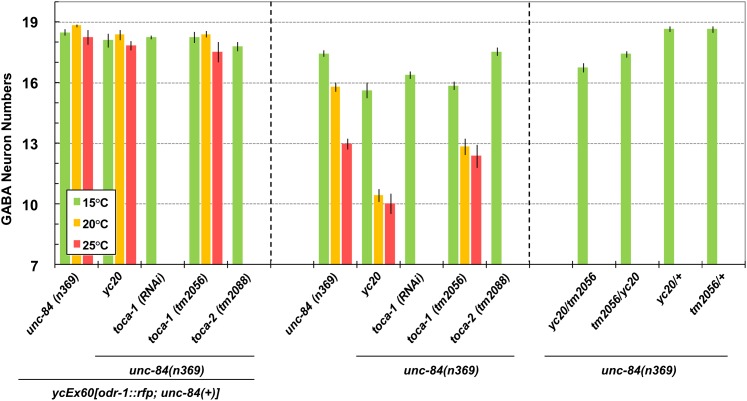Figure 5 .
toca-1 RNAi or a deletion allele enhance unc-84. (Left) yc20, toca-1(RNAi), toca-1(tm2056), and toca-2(tm2088) have similar average GABA neuron numbers in comparison with unc-84(n369) ycEx60[odr-1::rfp; unc-84(+)] animals at all temperatures. (Center) At 15°, yc20, toca-1(RNAi), and toca-1(tm2056) showed significantly lower GABA neuron numbers (15.6 ± 0.4, 16.4 ± 0.2, and 15.9 ± 0.2, respectively) than unc-84 (17.5 ± 0.2) (t-test; P < 0.0001). However, at 15° toca-2(tm2088) and unc-84 showed similar GABA neuron numbers (17.5 ± 0.2 vs. 17.5 ± 0.2). At 20°, yc20 and toca-1(tm2056) showed significantly fewer GABA neuron numbers (10.5 ± 0.3 and 12.9 ± 0.4, respectively) than unc-84 (15.8 ± 0.2) (t-test; P < 0.0001). At 25°, yc20 showed significantly lower average GABA neuron numbers (10.0 ± 0.5) than unc-84 (13.0 ± 0.3) (t-test; P < 0.0001) but toca-1(tm2056) showed similar numbers to unc-84 (12.4 ± 0.6 vs. 13.0 ± 0.3). (Right) Both yc20/tm2056 and tm2056/yc20 (male X chromosome/hermaphrodite X chromosome) trans-heterozygous animals showed significantly lower average GABA neuron numbers (16.8 ± 0.2 and 17.4 ± 0.2, respectively) than yc20/+ and tm2056/+ (18.7 ± 0.1 and 18.7 ± 0.2, respectively) (t-test; P < 0.0001). Sample sizes are all >20 L4 or young adult animals, and error bars show the standard error of the mean (SEM).

